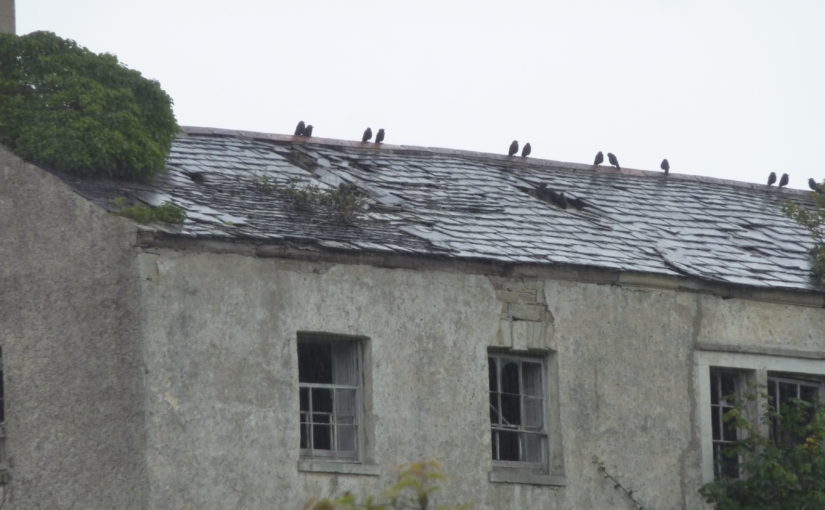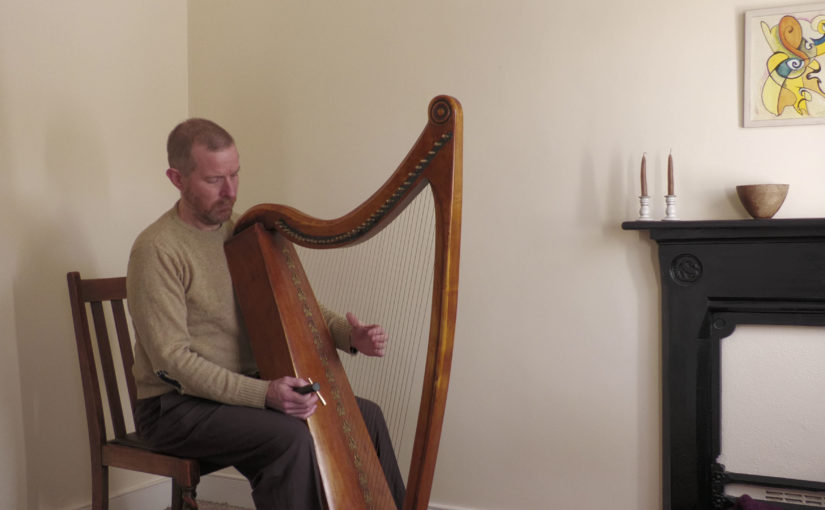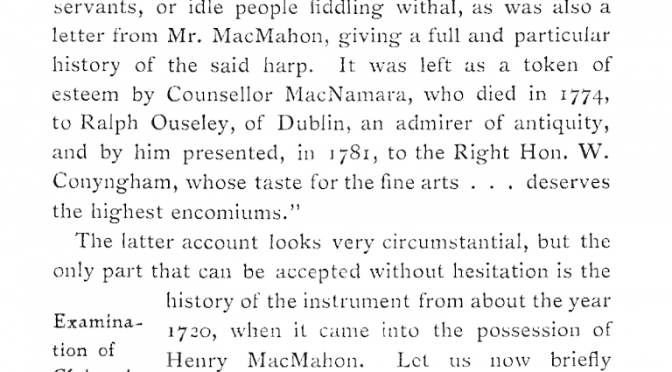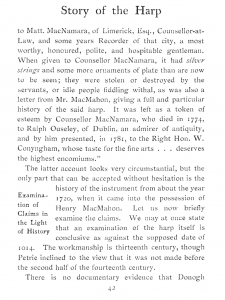I feel like I am not making much progress going through the “Damn your Body” pamphlet, because even after looking closely at each notation I don’t have much to say about whether it is a harp transcription or how it fits into the old harp tradition. I fear that this next tune, D’éalaigh Máire Liom, on page 192, is another unsatisfactory one. But I’ll do a summary post on it, because the only other option is to give up and skip over it, and I am not ready to do that yet. I would rather have an informed opinion about every page of the manuscript, even if that opinion ends up being “I have no idea what is going on with this notation”.
Continue reading D’éalaigh Máire LiomTag: mystery
Colonel Irwin
In Queen’s University Belfast, Special Collections, MS4.29 page 20, there is a line of dots which I have always marked as “unidentified tune”. I just could not work out what is going on here.
However Sylvia Crawford has analysed the mode of the dots and suggests that they represent Bunting’s first attempt to transcribe a harp version of the tune of DOSC 60 Colonel Irwin.
Continue reading Colonel IrwinTwo mystery tunes
One of the fun parts of my Old Irish Harp Transcriptions Project is discovering previously unrecognised or neglected live “dots” transcriptions of well-known tunes, most spectacularly with the Fairy Queen. And so the corollary is that one of the most irritating parts of the project is to find clear complete transcriptions of tunes that I cannot recognise from anywhere else.
Continue reading Two mystery tunesGrant of Sheuglie’s Contest betwixt his Violin, Pipe and Harp
I was contacted recently by a descendent of Alexander Grant of Shewglie, the early 18th century poet, piper, harper and fiddler. Alex Grant was a very interesting character, heavily involved in the Jacobite risings. He is said to have been a good poet or songwriter, but as far as I can see none of his poems survive. We know some details about two of them, but we dont have the text of either.
Grant composed a song in welcome to Charles Edward Stewart; it begins
Do bheatha Thearlaich Stiubhart,
Do bheatha do ar duthaich
which means basically, “welcome, Charles Stuart, welcome to our place”. Keith Sanger (West Highland Notes & Queries 20, March 1983) suggests it may be in a manuscript belonging the National Library of Scotland (no. 6 of the MacNicol collection, MS Acc2152), but this manuscript appears to be missing from the library.
Grant also composed a song, a “contest betwixt his Violin, Pipe and Harp”. The tune of this, and also an English paraphrase of the words, was published in Simon Fraser’s book in 1816. We are told that the fiddle is addressed as “Mairi nighean Dheorsa” (Mary the daughter of George), and this seems to have been also a title of the tune.
I think the tune is an older traditional song air; Allan MacDonald in his Thesis connects it to the pipe “March for a Beginner” in Joseph MacDonald’s Complete Theory. Perhaps more intriguingly, the tune is said to have been used for other songs in the 18th century, a poem by Ardnabi in praise of a fiddle, Mairi nighean Dheorsa, and another famous poem in praise of MacCrimmon’s bagpipes. What is the connection between this tune and the name Mairi nighean Dheorsa given to a fiddle? The later Ardnabi poem not only uses the name for the fiddle but also says that the air to be used when singing the poem is “Mairi nighean Dheorsa”. Did both Ardnabi and Grant pick up an older tune called Mairi nighean Dheorsa and use it to praise their fiddles, or did Grant pick up an older generic song air and attach it to the Mairi nighean Dheorsa name and theme?
Here’s my version of it. I decided to pick up on the themes of Fraser’s paraphrase of Grant’s song, so the first and fourth of my verses are fairly straight from Fraser’s fiddle score; for verses two and three I have improvised a pipe-style and a harp-style interpretation of the melody.
It’s also interesting to think that Alexander Grant, of Shewglie in Glen Urquhart, was a contemporary of Raghnall Mac Ailein Óig, of Morar; both are said to have played pipes, fiddle and clarsach.
Silver strings on the Trinity College harp
I was browsing idly through a first edition of Grattan Flood’s The Story of the Harp in the Wighton Centre in Dundee the other week, when I came across the description of the Trinity College or Brian Boru harp on pages 41-42. An 18th century letter is quoted, giving some description of the harp:
It says “When given to Counsellor MacNamara, it had silver strings…”
The letter is said to have been written by Ralph Ouseley, who owned the harp in the early 1780s. Macnamara acquired the harp in about 1756. If this is true then it is an exciting and important piece of information both about the Trinity College harp itself, and also about the use of precious metal strings on the old Gaelic harps.
Now Grattan Flood is a notoriously unreliable author, and many of his statements can be proved false by laboriously tracking down the source documents to see what he says. Often he gives no citation or only a vage reference to “an old manuscript”. This section is given a citation though: “Bibl. Egerton, Brit. Mus., No. 74, p.351”
I contacted the British Library, and put in a request for a copy of this manuscript page. After some confusion and digging on the part of the librarians, (and a rather eye-watering fee on my credit card for their troubles) I was sent a high-res page scan of British Library, ms Egerton 74 f184. This page contains a transcription made by J. Hardiman in 1820, of the Ouseley letter, and Grattan Flood is vindicated – it really does say that the harp had silver strings on it. I was delighted that my expensive gamble in ordering the manuscript page had paid off – worth its weight in silver you could say!
So I wonder, what is the story here? Was the harp strung entirely with silver? Or did it only have a certain section of the strings left? I have seen a photo of an 18th century Irish harp (one of the Malahide / Kearney ones) which had all of its steel trebles on but none of its brass basses; brass being more valuable to remove and recycle I suppose. When were these silver strings installed on the Trinity College harp? There is no suggestion that the harp was played in the early 18th century; Arthur O’Neill in about 1760 implies that the instrument was not played for 200 years before then. Were these silver strings the remains of a 16th century setup?
The genuineness and authority of this statement from an 18th century owner of the harp makes me want to start experimenting again. How does it work to fit silver strings to the entire range? Can it be taken up to the high treble? What alloys work best for this? Ann Heymann tells me she has had a low-headed medieval Irish harp strung entirely in silver, but more experiments are needed!
A German or Scandinavian harper in Ireland c.1800?
The front cover of Collette Moloney’s book, The Irish Music Manuscripts of Edward Bunting, an Introduction and Catalogue, published in 2000 by the Irish Traditional Music Archive, shows an oil painting of an elderly gentleman holding a harp.
The caption on the back of the book says “Front cover ‘A Portrait of a Harper’, Irish School, c. 1800 (formerly attributed to James Barry: courtesy National Gallery of Ireland)”.
So if we trust the art experts who give these very definitive sounding opinions, this is a portrait painted in Ireland by an Irish artist about the year 1800. But who is the harpist?
I long ago recognised that the harp in the painting is of a type known today as a ‘Bohemian harp’, it is a type of instrument that was native to Germany but was also widely used in Scandinavia. The most diagnostic part of the harp really in this painting is the little soundholes arranged in a cross shape. But other aspects of it – the general shape of the instrument, the pale soundboard compared to the dark wood of the rest of the instrument, (not to mention the very un-Irish right hand treble) all indicate it is a German or Scandinavian harp of the late 18th century.
(Once I realised it was a German or Scandinavian harp in the picture, I started thinking that the man’s face looked quite Germanic as well).
Just this week I was looking at the online facsimiles of the Journal of the Folk Song Society of Ireland (more info on my Bunting mss page) and I noticed, in an article about Samuel Fergusson (vol vii p.11), a mention of the Swedish harpist Herr Sjoden, who visited Ireland in 1879.
I have not yet found a portait of Adolf Sjödén (1843-1893) for comparison – could he be our man I wonder?






